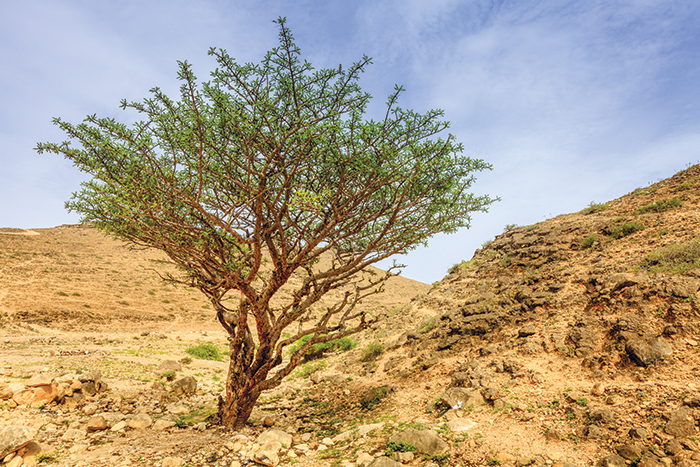
Knowing when and how to harvest frankincense are the most important points to remember in order to conserve them.
Research on sustainable growth of the treasured tree was conducted by the Environment Society of Oman, and then shared with frankincense growers, cultivators and nature enthusiasts to spread awareness of such practices.
The study was led by Dr Mohsin Al Amri and field assistant Badar Al Shanfary, over a period of four years (2010 to 2014), during which they monitored 180 naturally grown trees – which go by the scientific name of boswellia sacra – across four locations, and also surveyed the readings from three meteorological stations to measure the impact of weather on frankincense yield.
“For more than 5,000 years, boswellia sacra trees in Oman’s Dhofar region have been tapped for a rare, aromatic resin across Arabia, Africa and Europe, mostly known as frankincense (or olibanum),” said the ESO. “This much sought-after resin has been used for centuries in cultural ceremonies, but also as a cosmetic agent, and as traditional medicine to treat a variety of ailments.
“Frankincense is deeply meshed into the Omani identity, and its production persists to this day,” they added. “But its future is unclear, with incorrect tapping practices and overgrazing – among other threats – placing frankincense trees at risk.”
These two threats aside, other adversities faced by frankincense trees include damage by insects, and the disturbing of the land while mining activities are carried out.
The boswellia tree is most famed for its resin. Harvesters tap into the side of the tree by making small cuts into the bark, extracting a milky-white substance that, when hardened, crystallises into the frankincense that is still sold all over the world.
Research by the ESO found that cuts measuring about 12 sq cm and 30cm apart from each other are optimal for both successful harvests and long-term viability of trees. Between March and April, trees can be harvested every 14 days, while from November to May, the resin can be extracted once every 21 to 28 days.
It is important that harvesting stops two to three weeks prior to the rainy season, so that the incisions made into the bark can heal, while it is also recommended that this cycle of harvesting be continued for three years, before allowing for the trees to rest for one to two years so that they can heal.
“A tree reaches its maximum yield productivity in the third or fourth harvesting sequence, and in the third harvesting year,” explained ESO. “The lower part of the tree trunk produces more resin compared to the upper parts of the trunk.”
The study, which was funded by HSBC, also revealed that the amount of resin a tree will yield depends on three factors: tree height, trunk size and tree foliage cover. Trees, for example, that are more than three metres tall and on the thicker side, can have between 10 and 18 tapping spots.
Thinner trees can have anywhere between five and 12 spots, with the number of spots available proportional to the amount of foliage present in a tree. For trees ranging from heights of one to three metres, anywhere between a single and six tapping spots can be found.
The advice on sustainable frankincense harvesting has been released by the ESO in the form of a brochure that can be found on their website, www.eso.org.om.